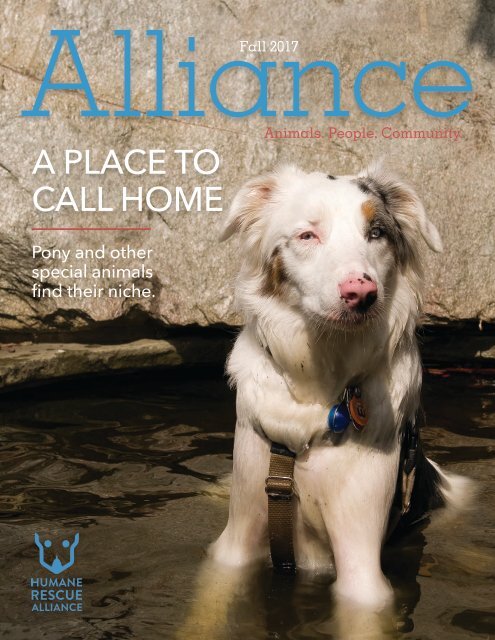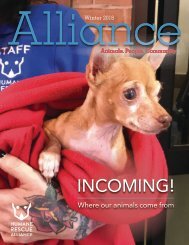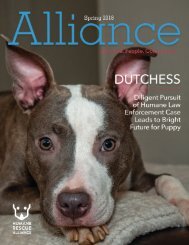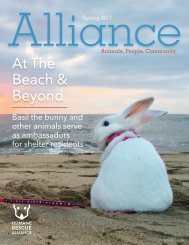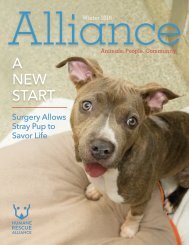You also want an ePaper? Increase the reach of your titles
YUMPU automatically turns print PDFs into web optimized ePapers that Google loves.
<strong>Alliance</strong><br />
Animals. People. Community.<br />
A PLACE TO<br />
CALL HOME<br />
<strong>Fall</strong> <strong>2017</strong><br />
Pony and other<br />
special animals<br />
find their niche.<br />
ALLIANCE<br />
1
LETTER FROM THE PRESIDENT AND CEO<br />
Dear Friends,<br />
Editor: Pam Townsend<br />
Cruelty/Neglect Reports:<br />
202-723-5730, press 1<br />
Cruelty reports accepted 24 hours a day.<br />
Animal-Related Emergencies:<br />
202-576-6664, press 1<br />
Main Number: 202-723-5730<br />
Adoptions (New York Ave.):<br />
202-727-5494<br />
Adoptions (Oglethorpe): Ext. 503<br />
Behavior and Training: Ext. 236<br />
Development: Ext. 315<br />
Finance: Ext. 326<br />
Media Inquiries: Ext. 267<br />
Special Events: Ext 323<br />
HOURS AND LOCATIONS<br />
71 Oglethorpe Street, NW<br />
Washington, DC 20011<br />
Adoption Hours: 12 p.m. – 7 p.m. daily<br />
Closed for adoptions on Mondays.<br />
1201 New York Avenue, NE<br />
Washington, DC 20002<br />
Adoption Hours: 12 p.m. – 7 p.m. daily<br />
Closed for adoptions on Mondays.<br />
Stray animals are accepted<br />
24 hours a day at New York Ave.<br />
BOARD OF DIRECTORS<br />
Roger Marmet...................Chair<br />
Jay Timmons......................First Vice President<br />
Lisa LaFontaine................President and CEO<br />
Amy Meadows..................Second Vice President<br />
Gwyn Whittaker..............Secretary<br />
Hon. Mary Schapiro......Treasurer<br />
<strong>The</strong>resa Fariello...............Vice President<br />
William Herman..............Vice President<br />
Gregory Riegle.................Vice President<br />
Lauren Talarico DVM, DACVIM<br />
Nina Benton<br />
Steven Bralove<br />
Priscilla Clapp<br />
Saone Crocker<br />
Pamela DeLoach-Jupiter<br />
Jackie Dobranski, DVM<br />
Louie Dweck<br />
Colleen Girouard<br />
Anissa Grossman<br />
Leslie Harris<br />
William Harrop<br />
Joseph Howe<br />
Kenton Keith<br />
Erika Kelton<br />
Betsy Marmet<br />
Matthew Parker, MD<br />
Laird Patterson<br />
Susan Ridge<br />
Robert Rosenfeld<br />
Erica Scherzer<br />
Hon. Carol Schwartz<br />
Andrew Weinstein<br />
Charles Weir<br />
Jean Whiddon<br />
Drew Willison<br />
Jeff Wilson<br />
Lois Godfrey Wye<br />
“Special”— many people use this word to describe the animals in their<br />
lives. Usually, this adjective describes the strength and intensity of the<br />
relationship we share with them. It also may refer to an unusual or<br />
unique ability, a physical abnormality or disability, or even a singular<br />
personality trait.<br />
I am lucky to have shared my life with dozens of animals who were—<br />
and are—special in one way or another. <strong>The</strong>y include Merlin the<br />
cat and my dog Sazzy, both of whom I wrote about in my <strong>Alliance</strong><br />
message in the spring. <strong>The</strong>ir stories and situations aren’t unique. Many<br />
of my colleagues at the Humane Rescue <strong>Alliance</strong> (HRA) have—or<br />
have had—animals they describe as special.<br />
• Lauren Lipsey, vice president of community programs, rescued<br />
two street dogs in Chile. One, a tennis ball thief, lived on scraps<br />
fed to him by local children, and the other was found at the age of 2 months, scrounging<br />
for food in a trash heap on the side of the road. Although Lauren says she’d never been an<br />
“animal” person before she met Oreo and Lily, she knew she couldn’t leave them behind<br />
when she returned to the States. Not only did they go home with her, they were the reason<br />
she got into the animal welfare field.<br />
• Media coordinator Pam Townsend and her husband adopted a puppy who was frightened<br />
by many things—the sound of the dishwasher and refrigerator ice machine, umbrellas<br />
being opened, a black briefcase, plastic trash bags, to name a few—and acted aggressively<br />
toward unfamiliar people and most other dogs. Although life with Tango was a challenge,<br />
Pam says the effort involved in managing him actually strengthened the unique bond they<br />
shared. She also learned more about dog behavior than she ever imagined and met people<br />
who not only improved Tango’s life but also enriched hers.<br />
• Stephanie Shain, chief operations officer, had no intention of adopting foster kitten Mae.<br />
Rescued by Animal Control Officers, the tiny girl was found dangling from a fence by her<br />
leg, which was so badly damaged that it had to be amputated. Stephanie agreed to take<br />
care of Mae for “a few days.” But the kitten’s irrepressible spirit and joie de vivre—which<br />
remained intact throughout some post-surgery complications—made it impossible for<br />
Stephanie to give her up. Today this “small and sassy and amazing” feline lives life to the<br />
fullest with no idea that she’s different from other cats.<br />
• Like Stephanie, Alison Putnam, director of finance and administration, thought her<br />
relationship with Dolley would be temporary. She and Dolley went through more than a<br />
year of service dog training, but in the end evaluators determined that despite knowing<br />
upward of 50 commands, Dolley was too social and loved people too much to work as a<br />
service dog. Instead, she took all the wonderful training she’d received and applied it to a<br />
new “career” as a therapy dog. She and Alison visit the Armed Forces Retirement Home on<br />
a regular basis, bringing comfort and joy to both residents and their family members.<br />
<strong>The</strong>se are just a few of the examples of the “special” animals HRA staff share their lives with.<br />
You can read more about their stories, along with others, at humanerescuealliance.org/special.<br />
We also encounter special animals every day at our adoption centers. <strong>The</strong>y may look different<br />
because of a physical injury or they may have been born blind or deaf, as in the case of Pony,<br />
the dog on the cover of this issue. <strong>The</strong>y may be species that most people would never even<br />
consider as pets. Our goal is to match people with companion animals of all varieties.<br />
Not every animal is suited to life in a home, but that doesn’t mean we give up on them; it just<br />
means we have to be creative in finding them a niche as special as they are. Our new program,<br />
Blue Collar Cats, is an excellent example of such an effort. Operated in partnership with our<br />
community cat program, Blue Collar Cats is a rehoming initiative that puts cats to work—in local<br />
businesses and residences—doing what they do best, in return for food, shelter, and basic care<br />
by human “landlords.” Although only in its infancy, this program is off to a great start, with both<br />
people and cats doing well. One Blue Collar Cat named Lady Dole even received a brand-new<br />
(second!), multi-level kitty condo as a “performance reward” from her human guardians.<br />
I hope you enjoy reading about a few special animals in this issue of <strong>Alliance</strong>.<br />
2 ALLIANCE
LEAP OF FAITH<br />
By Doug Conomy and Alejandro Salinas, Adopters<br />
Nearly 3 years ago, we walked into the Humane Rescue<br />
<strong>Alliance</strong> (HRA) looking for a dog. We’d been talking about the<br />
idea for months: learning about the adoption process, reading<br />
up on dog breeds, and considering how our lives would be<br />
impacted. As we started our search, we felt confident and<br />
prepared. <strong>The</strong>n we met Pony.<br />
At just 7 months, Pony was a stunner: an Australian shepherd<br />
puppy from Alabama with a black-and-tan merle coat and<br />
a bright pink nose. He was sweet and lively and, as his<br />
information card stated in bold letters, deaf.<br />
Pony was the first deaf dog we’d come across and, despite<br />
being smitten with him, our ignorance about his circumstance<br />
gave us pause. We hadn’t prepared for this scenario: we<br />
had so many questions about care and training but no real<br />
answers. All we had was a feeling—a feeling that told us we<br />
belonged with Pony. So we took a leap of faith.<br />
With an application submitted, we left HRA determined to<br />
educate ourselves about deaf dogs. We looked at books and<br />
websites and that’s how we found Deaf Dogs Rock, a nonprofit<br />
organization dedicated to the care of deaf dogs. <strong>The</strong><br />
organization’s website has training tips, articles, testimonials,<br />
and even a directory of deaf dogs in need of adoption. We<br />
used it to learn about hand signals and unique behavioral<br />
traits—like how deaf dogs require proximity to their human to<br />
feel comfortable.<br />
ALLIANCE<br />
3
Having done our homework, we felt ready for Pony’s arrival but, once again,<br />
we were wrong.<br />
Pony’s first weeks at home weren’t easy. We struggled to bridge the<br />
communication gap, unable to get him to understand us. Long walks didn’t<br />
seem to tire him and he showed little interest in training. Over time, we<br />
became increasingly frustrated and we could tell Pony was, too. When he<br />
started nipping and barking at us on walks, we knew our situation had become<br />
untenable.<br />
Right around that time, a co-worker recommended Gwen Podulka (dogtrained.<br />
com), a dog trainer and owner of a deaf dog herself. We set up a meeting but,<br />
frankly, our expectations were low. We were ready to give up. But Pony wasn’t.<br />
Within the first minutes of meeting Gwen, Pony had learned to go to his bed<br />
on command. Clearly, Pony was eager to engage and Gwen had tuned into<br />
his channel. During the hour and a half she spent with us, Gwen taught us we<br />
needed to talk in Pony’s language and not the other way around. Pony knew<br />
what he was doing all along—we were the ones who needed training!<br />
Using clear signals, constant visual contact, and high-reward treats, she<br />
walked us through several sign commands (sit, come, bed). We learned that<br />
for dogs, mental stimulation can often be more tiring and rewarding than<br />
physical activity. After the session, Pony was visibly exhausted for the first time<br />
since coming home.<br />
That session transformed our relationship with Pony. Since then, the learning<br />
hasn’t stopped: he’s mastered about 30 commands (a combination of ASL<br />
signs and our own) and growing, and has been happily doing agility training on<br />
a regular basis for more than 2 years.<br />
“<br />
We needed to<br />
talk in Pony’s<br />
language and<br />
not the other way<br />
around. Pony<br />
knew what he<br />
was doing all<br />
along —we were<br />
the ones who<br />
needed training!<br />
”<br />
4 ALLIANCE
Looking back, Gwen was right (she usually is) when she told us Pony<br />
was a once-in-a-lifetime dog. At the time, it was a little hard to believe,<br />
but now it’s obvious how Pony has and continues to enrich our lives.<br />
Thanks to him, we’ve challenged our assumptions about deaf dogs<br />
and discovered a passion for sharing this knowledge with others.<br />
A year and a half ago, Pony got a little sister, Puma, a deaf Catahoula/<br />
Australian shepherd mix rescue from Florida. Training has been easier<br />
the second time around, with Puma quickly picking up commands<br />
from watching and mimicking Pony. If you’d like to stay up to date on<br />
their adventures or just say hello, you can find them on Instagram by<br />
searching for the handle @pony_the_dog.<br />
ALLIANCE 5
New Rehoming Options for Cats<br />
By Erin Robinson, Community Cat Program Manager<br />
Jojo came to the Humane Rescue <strong>Alliance</strong> (HRA)<br />
with her litter of three newborn kittens in early<br />
<strong>2017</strong> from an area where she could not safely be<br />
returned after her kittens finished nursing. <strong>The</strong><br />
pretty black-and-white feline had a safe place with<br />
HRA to help her kittens grow up and get ready for<br />
adoption, but since she had never been socialized<br />
with people, she wasn’t interested in being a lap<br />
cat. That’s when her resume went up for Blue Collar<br />
Cats, and a local theater was matched with Jojo<br />
as their newest hire! Jojo now stalks the costume<br />
and props storage as well as the rehearsal spaces<br />
and offices, ridding the theater of their persistent<br />
mouse problem. She sometimes even gives notes<br />
on performances!<br />
Poser had lived his whole life outdoors with his<br />
caregiver in Northeast DC, and he had a pretty good<br />
life. Sadly, his caregiver passed away and there was<br />
no one in the neighborhood to provide Poser with<br />
food and outdoor shelter. So the 2-year-old tabby<br />
came to HRA to find a better outcome. Since he’d<br />
always lived outside, Poser very much wanted<br />
to continue living in the great outdoors; thus, he<br />
was paired with a new caregiver: a homeowner in<br />
Capitol Hill who previously cared for a community<br />
cat and was looking for another to help with the rat<br />
issues that are all too familiar to DC residents. Poser<br />
now keeps her backyard and alley pest free—and<br />
provides endless photo opportunities.<br />
Poser and Jojo are just two of the more than<br />
20 cats whose lives have been saved since the<br />
launch of a new HRA program called Blue Collar<br />
Cats in January <strong>2017</strong>. Felines in this program are<br />
community cats who do a great job at deterring<br />
and controlling rodents. But every so often, one of<br />
them ends up in our care.<br />
Since they’re not ideal pets, these cats would<br />
normally be candidates for CatNiPP, HRA’s Trap-<br />
Neuter-Return (TNR) program, if they had a safe<br />
place to return to. However, such safe places<br />
aren’t always available due to known abuse in the<br />
area, the death of the cats’ caregiver, or even the<br />
razing of the entire neighborhood for development.<br />
And that’s where Blue Collar Cats comes in. A<br />
rehoming initiative operated in partnership with our<br />
community cat program, Blue Collar Cats puts the<br />
6 ALLIANCE
cats to work—in local businesses and residences—doing<br />
what they do best. It gives them a chance at a fruitful life<br />
while benefitting their new caregivers with effective and<br />
non-toxic pest control.<br />
Essentially, the program is the next step in saving every<br />
animal possible, even the cats whose behavior may not<br />
make them good house pets. All the cats taken into the<br />
program are sterilized, vaccinated against rabies and<br />
feline distemper, eartipped, and microchipped so they’re<br />
healthy and not interested in roaming or adding to the<br />
population.<br />
<strong>The</strong>re’s no one perfect place for a Blue Collar Cat; with<br />
appropriate space to hide from people and noise and<br />
a shelter to provide protection in cold or rainy weather,<br />
anywhere can be a great space for these special felines.<br />
Homeowners in Georgetown, Logan Circle, Shaw,<br />
Capitol Hill, and even Manassas, VA, as well as a brewery,<br />
hardware store, theater, and several restaurants have<br />
brought on Blue Collar Cats. <strong>The</strong> expectations of anyone<br />
“employing” a Blue Collar Cat are to provide daily food and<br />
clean water, shelter, and basic health care throughout the<br />
cat’s lifetime. And we’re already hearing from caregivers<br />
how hard these cats work: from an overall reduction in<br />
rodent sightings to seeing the cats in action!<br />
You can find out more about the Blue Collar Cats program<br />
and sign up to partner with us in this amazing and<br />
innovative new venture at humanerescuealliance.org/<br />
BlueCollarCats.<br />
“<br />
Poser and Jojo are just<br />
two of the more than<br />
20 cats whose lives<br />
have been saved since<br />
the launch of a new<br />
HRA program called<br />
Blue Collar Cats in<br />
January <strong>2017</strong>.<br />
”<br />
ALLIANCE<br />
7
Snakes and Spiders<br />
and Lizards, Oh My!<br />
By Pam Townsend, Media Coordinator<br />
<strong>The</strong> vast majority of people who pass through the<br />
doors of the Humane Rescue <strong>Alliance</strong> (HRA) in search<br />
of an animal companion head straight for the available<br />
dogs or cats or perhaps even the rabbits. But some are<br />
looking for something a bit different.<br />
Every year, in fact, HRA finds homes for several dozen<br />
exotic animals—think snakes, spiders, and lizards—with<br />
the number topping 200 in 2016.<br />
Take Charizard for example. This 3-year-old female<br />
iguana was adopted last year by Parrie Henderson-<br />
O’Keefe and her son. <strong>The</strong> animal-loving twosome were<br />
no strangers to unusual pets, having had a Russian<br />
tortoise, a fat-tailed gecko, and an assortment of toads,<br />
hamsters, and Anole lizards over the years, along with<br />
a dog and a couple of cats.<br />
“My son loves reptiles and wants to study herpetology<br />
in college,” says Henderson-O’Keefe. “We were quite<br />
intrigued by Charizard, and since my son seemed to<br />
have a connection with her, we decided to adopt her.”<br />
Today, the large lizard spends her days eating, sleeping,<br />
and lounging on a cat tree in the sunshine that pours<br />
through the skylight in Henderson-O’Keefe’s top<br />
floor art studio. A heating pad and heat lamp provide<br />
additional warmth when needed. Every few weeks,<br />
she’ll go on a walkabout, wandering around the studio<br />
or even heading downstairs to explore other rooms.<br />
On the other end of the size spectrum is Ducky, a<br />
1.5-year-old leopard gecko, who found his way to HRA<br />
following an eviction. Fortunately, it didn’t take long<br />
for this little lizard to find a new home with Delaware<br />
8 ALLIANCE
“<br />
To anyone interested in<br />
adopting an exotic animal,<br />
Daniels has three words of<br />
advice: Research, research,<br />
research!<br />
”<br />
resident Grace Clampitt. Although Clampitt had never<br />
had a leopard gecko, she had previously cared for two<br />
bearded dragons, and had the lamps and enclosure<br />
necessary for housing a reptile. She reports that Ducky is<br />
doing well and enjoying his diet of meal worms along with<br />
the occasional wax worm—a particular favorite of his.<br />
Like Charizard and Ducky, Scuba Steve wouldn’t be the<br />
pet of choice for most people but, thanks to HRA, this<br />
bark scorpion also found the right home. Discovered<br />
in an apartment hallway last December, Steve—who,<br />
it turns out, is actually Stephanie—was rescued by<br />
HRA Animal Care and Control Officers and taken to<br />
the New York Avenue Adoption Center, where she<br />
quickly caught the eye of HRA Law Enforcement officer<br />
Stephon Daniels.<br />
“I’ve always loved exotic pets,” says Daniels. “As a child<br />
I watched documentaries and shows that depicted<br />
animals in their natural environment. Now I enjoy setting<br />
up enclosures for them as close to their natural habitat as<br />
possible. I already had nine tarantulas of various species<br />
and wanted a scorpion as well.”<br />
Before bringing Stephanie home, Daniels, who has<br />
more than 20 years of experience caring for exotic<br />
pets, researched both the legality of owning—and the<br />
responsibilities of caring for—a scorpion. Today, she lives<br />
comfortably in her own secure enclosure.<br />
“She’s awesome,” says Daniels, who recently introduced<br />
Stephanie and a couple of his tarantulas to youngsters<br />
at HRA’s Caring Kids Camps. “When I’m working on my<br />
artwork late at night and look up, I’ll see her patrolling her<br />
personal territory.”<br />
To anyone interested in adopting an exotic animal, Daniels<br />
has three words of advice: Research, research, research!<br />
<strong>The</strong>se animals often have more specific and possibly<br />
more time-consuming care requirements than more<br />
traditional pets, and if people aren’t properly prepared,<br />
the animals end up in shelters or worse.<br />
ALLIANCE<br />
9
30th<br />
Annual<br />
BARK BALL raises $700,000<br />
Thank you to everyone who supported the 30th<br />
Annual Bark Ball. This year’s event was the largest<br />
to date, with 1,200 guests and more than 500 of DC’s<br />
best dressed dogs in attendance. <strong>The</strong> Washington<br />
Hilton served as the perfect backdrop for one of<br />
the region’s most sensational charity galas, which<br />
raised more than $700,000 to benefit the Humane<br />
Rescue <strong>Alliance</strong>’s (HRA) critical community services.<br />
Guests enjoyed exciting silent and live auctions,<br />
a delicious dinner, and a touching program led<br />
by event host Wendy Rieger, NBC4 anchor. Other<br />
special guests included the Honorable Bob Dole<br />
and Honorable Elizabeth Dole along with their pups<br />
Blazer and Leader, as well as Diana Bulger, the<br />
chair of the first Bark Ball in 1988. We are extremely<br />
grateful for their continued support of HRA.<br />
This year’s live auction excited our generous donors.<br />
Many were inspired by the Doles’ presence to bid<br />
on two personally autographed copies of Unlimited<br />
Partners. However, the auction package of the<br />
evening was an Exclusive On-Field Washington<br />
Nationals Experience. This package included a<br />
one-hour pitching lesson with Max Sherzer, starting<br />
pitcher for the Nationals; on-field batting practice<br />
with the whole team; and tickets in the exclusive<br />
Diamond Club. A bidding war was resolved when<br />
the donors, Erica and Max Scherzer, graciously<br />
decided to provide the experience to two winners,<br />
each of whom pledged $10,000. This brought in<br />
$20,000 for HRA, our animals, and our services for<br />
the community.<br />
Thank you to all of our incredible sponsors,<br />
especially Louie and Ralph Dweck, U.S. Chamber of<br />
Commerce, National Association of Manufacturers,<br />
and TTR Sotheby’s International Realty.<br />
We also want to thank our Bark Ball Chair Terri<br />
Fariello, whose leadership and engagement of a<br />
strong volunteer team helped make this success<br />
possible!<br />
10 ALLIANCE
IN HONOR AND MEMORY<br />
Tributes listed here were received April 16, <strong>2017</strong> through July 15, <strong>2017</strong>.<br />
ALLIANCE<br />
11
IN HONOR AND MEMORY Continued<br />
from Page 11<br />
WEBSITE<br />
FACEBOOK<br />
humanerescuealliance.org<br />
facebook.com/humanerescuealliance<br />
INSTAGRAM<br />
TWITTER<br />
instagram.com/humanerescue<br />
twitter.com/humanerescue<br />
15-WHSDC-0917-N


